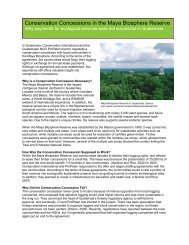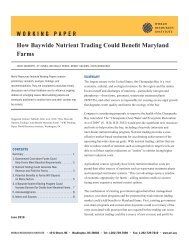APPENDIX GWETLAND MITIGATION BANKING: SUMMARY CHART (continued)Study Location Description Results: Permit Success Results: Ecological Success Notes: WildlifeTurner et al.(2001)Wilson andMitsch (1996)– From NRC(2001)Zedler andLangis (1991),Zedler andCallaway(1999), Zedleret al. (1997) –From Ambrose(2000)Zenter (1987)– FromAmbrose(2000)NationwideCaliforniaCaliforniaDetailed analysis <strong>of</strong> peer reviewed andgrey literature on <strong>the</strong> performance<strong>of</strong> wetland mitigation under §404 --includes Sudol 1996, Allen and Feddema1996 and DeWeese 1994Evaluated 5 wetland projects in detail forpermit compliance and function.An extensive study on two mitigationprojects in San Diego.Qualitative examination <strong>of</strong> 63 coastalwetland res<strong>to</strong>ration projects.In eight reviewed studies <strong>the</strong> proportion<strong>of</strong> mitigation initiated ranged from 28- 100 percent. In 19 studies <strong>of</strong> permitcompliance, 10 found a majority <strong>of</strong>projects <strong>to</strong> be in compliance, 9 studiesfound that only 4 - 49 percent <strong>of</strong> <strong>the</strong>projects were compliant. In 8 studies <strong>of</strong>5 state permitting programs, 2 foundthat area <strong>of</strong> mitigation achieved equaledor exceeded <strong>the</strong> area <strong>of</strong> wetland lost,6 found <strong>the</strong> opposite. 9 studies <strong>of</strong> 4state permitting programs found fewerhectares <strong>of</strong> mitigation was implementedthan required by permits (average <strong>of</strong> .69hectares per hectare lost).2 <strong>of</strong> 5 projects were in full legal compliance,four <strong>of</strong> five were on <strong>the</strong> trajec<strong>to</strong>ry<strong>to</strong> full compliance.A review <strong>of</strong> studies on mitigation successfound that 21 percent <strong>of</strong> mitigation sitesmet various tests <strong>of</strong> ecological equivalency<strong>to</strong> functions lost (0 - 67 percentfunctionality), <strong>the</strong> compliance rate for<strong>the</strong>se sites was 6 - 100 percent.24.4 hectares were lost <strong>to</strong> impacts and 16hectares were actually created or res<strong>to</strong>red-- a net loss in wetlands.Five years after <strong>the</strong> construction <strong>the</strong> mitigationdid not meet 10 <strong>of</strong> 11 ecosystemfunctions, but did have a fish assemblagethat was comparable <strong>to</strong> wetland referencesite.65 percent exhibited roughly typicalwetland values as similar, unres<strong>to</strong>redwetlands.110 Environmental Law Institute
APPENDIX GBibliographyAllen, A. O., and J. J. Feddema. 1996. Wetland loss andsubstitution by <strong>the</strong> Section 404 Permit Programin sou<strong>the</strong>rn California, <strong>US</strong>A. EnvironmentalManagement 20: 263-74.Ambrose, R.F. 2000. Wetland Mitigation in <strong>the</strong> UnitedStates: Assessing <strong>the</strong> Success <strong>of</strong> MitigationPolicies. Wetlands (Australia) 19: 1-27.Ambrose, R.F. and S.F. Lee. 2004. An Evaluation <strong>of</strong>Compensa<strong>to</strong>ry Mitigation Projects PermittedUnder Clean Water Act Section 401 by <strong>the</strong> LosAngeles Regional Quality Control Board, 1991-2002.Ambrose, R.F., J.C. Callaway, and S.F. Lee. 2006. AnEvaluation <strong>of</strong> Compensa<strong>to</strong>ry Mitigation ProjectsPermitted Under Clean Water Act Section 401 by<strong>the</strong> California State Water Quality Control Board,1991-2002.Balzano, S., A. Ertman, L. Brancheau, W. Smejkal,A.S. Greene, M. Kaplan, and D. Fanz. 2002.Creating Indica<strong>to</strong>rs <strong>of</strong> Wetland Status (Quantityand Quality): Freshwater Wetland Mitigation inNew Jersey. NJ Department <strong>of</strong> EnvironmentalProtection, Division <strong>of</strong> Science, Research, &Technology. http://www.state.nj.us/dep/dsr/wetlands/final.pdfBishel-Machung, L., R.P. Brooks, S.S. Yates, andK.L. Hoover. 1996. Soil Properties <strong>of</strong> ReferenceWetlands and Wetland Creation Projects inPennsylvania. Wetlands 16:532-541.Breaux, A. and F. Serefiddin. 1999. Validity <strong>of</strong>Performance Criteria and a Tentative Modelfor Regula<strong>to</strong>ry Use in Compensa<strong>to</strong>ry WetlandMitigation Permitting. EnvironmentalManagement 24(3): 327-336.Brown, S.C. and P.L.M. Veneman. 2001. Effectiveness<strong>of</strong> Compensa<strong>to</strong>ry Wetland Mitigation inMassachusetts, <strong>US</strong>A. Wetlands 21: 508-518.Brown, S. and P. Veneman. 1998. Compensa<strong>to</strong>ryWetland Mitigation in Massachusetts.Massachussetts Ag Experiment Station, University<strong>of</strong> Massachusetts.Brown, P., and C. Lant. 1999. The effect <strong>of</strong> wetland mitigationbanking on <strong>the</strong> achievement <strong>of</strong> no-net-loss.Environmental Management 23(3): 333-345.Campbell, D.A., C.A. Cole, and R.P. Brooks. AComparison <strong>of</strong> Created and Natural Wetlands inPennsylvania, <strong>US</strong>A.Castelle, A.J., C. Conolly, M. Emers, E.D. Metz, S.Meyer, M. Witter, S. Mauermann, M. Bentley, D.Sheldon, and D. Dole. 1992. Wetland MitigationReplacement Ratios: Defining Equivalency.Adolfson Associates, Inc. for Shorelands andCoastal Zone Managements Program, Washing<strong>to</strong>nDepartment <strong>of</strong> Ecology, Olympia, Publication #92-08.Chase, V. and V. Davis. 1997. Evaluation <strong>of</strong> WetlandMitigation in New Hampshire. Audubon Society <strong>of</strong>New Hampshire.Cole, C.A. and D. Shaffer 2002. Section 404 WetlandMitigation and Permit Success Criteria inPennsylvania, <strong>US</strong>A, 1986-1999. EnvironmentalManagement 30(4): 508-515.Cole, C.A. and R.P. Brooks. 2000. A Comparison <strong>of</strong><strong>the</strong> Hydrological Characteristics <strong>of</strong> Naturaland Created Mainstem Floodplain Wetlands inPennsylvania. Ecological Engineering 14: 221-231.Cole, C. A., R.P. Brooks, and D.H.Wardrop. 2001.Assessing <strong>the</strong> Relationship between Biomass andSoil Organic Matter in Created Wetlands <strong>of</strong> centralPennsylvania, <strong>US</strong>A. Ecological Engineering 7:423- 428.DeWeese, J. and C. Gould. 1994. An evaluation <strong>of</strong>selected wetland creation projects authorizedthrough <strong>the</strong> Corps <strong>of</strong> Engineers Section 404Program. <strong>US</strong> Department <strong>of</strong> <strong>the</strong> Interior, Fishand Wildlife Service, Sacramen<strong>to</strong> Field Office,Sacramen<strong>to</strong>, California, 90 pp.Eliot, W. 1985. Implementing Mitigation Policies in SanFrancisco Bay: A Critique. California State CoastalConservancy. Oakland, CA.<strong>Design</strong> <strong>of</strong> U.S. <strong>Habitat</strong> <strong>Banking</strong> <strong>Systems</strong> <strong>to</strong> <strong>Support</strong> <strong>the</strong> <strong>Conservation</strong> <strong>of</strong> Wildlife <strong>Habitat</strong> and At-Risk Species 111
















